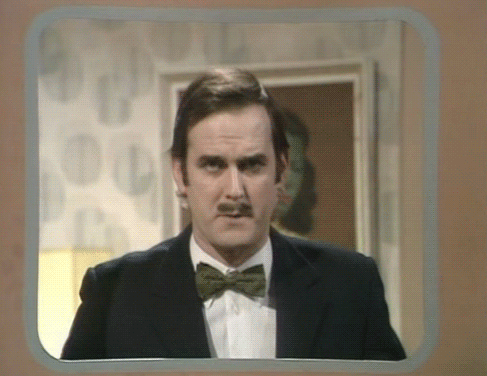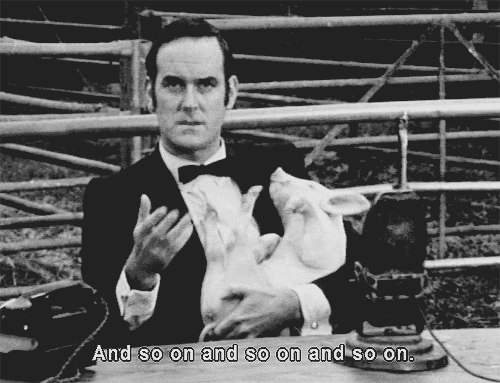Creativity comes easy to some, but when it comes to content marketing we are constantly tasked with being creative. Content Marketers must consistently come up with new ideas and concepts that will win over audiences and stand out from the noise of competitors, all while ever so subtly sharing our product information and building brand loyalty. Not so simple. At CMWorld, Monty Python alum John Cleese outlined three pillars of creativity that have helped him create, and more importantly replicate, pure creativity, and content marketers seeking new ideas should take note.
1. The Overnight Phenomenon
Cleese noted off the bat that no teacher ever noticed he had an ounce of creativity in school – even at Cambridge. He would act out but still couldn’t get the attention he craved. Eventually he realized that with a pen and a paper he could write things that would make people laugh. The problem with this, as most creatives understand, is sustaining and replicating the creative process – otherwise known as writers block.
Cleese said that at Cambridge, he would write and write and write until he came to a point when he didn’t know where to take the story. He was stumped. Instead of writing anything just to finish the story, he would leave the pen and paper on his desk and go to sleep. The next morning when he woke up, he would stroll over to the desk with a cup of coffee and finish it right then and there. He realized that during sleep, his mind was working on his story. This overnight phenomenon was actually his unconscious working on the creative process. Even when you don’t realize that your mind is being creative – if you put yourself in the right mind frame to create – your mind will do the rest.

Cleese noted how we all have some of our best ideas just as we’re falling asleep, and how inventor Thomas Edison frequently napped in his office with a handful of metal ballbearings over a metal bowl. The moment he fell asleep he’d be awakened by the clang of dropping the metal pieces into a metal bowl. He found he could easily solve problems and innovate in this space between being awake and asleep. Many content marketers face small teams and tight deadlines, but we should all try to build in time to “sleep on it” when working on a new piece or idea.
2. The Intelligent Unconscious
Cleese then dove into a story about how he once, to great embarrassment, lost a script mid-story and had to start from scratch. While he was writing the new one, he found the old one at the bottom of his desk. He then compared the two – the new one he wrote from memory was significantly better. The best elements of the old story came naturally while he was able to sprinkle a whole new element of even better details in the re-write.

He likens this creative process to being behind the wheel of your car on a random Tuesday. Sometimes you just drive for five or ten minutes and before you know it you have gone a few miles without even focusing on the details of the road. Your intelligent unconscious enables you take control without focusing on the minutia. Your mind will continue to build on what it has already learned, even in an unconscious state. What does this mean for content marketers? Maybe step away from a Google doc or boilerplate that has been read and redrafted 100 times. You never know what you might come up with when you start from scratch.
3. Hare Brain, Tortoise Mind
Lastly, Cleese recapped a book by Guy Claxton, entitled Hare Brain, Tortoise Mind: How Intelligence Increases When You Think Less. In his book, Claxton outlines two ways of thinking:
1. Hare Brain: The fast, purposeful, clear, precise, analytical way of thinking.
In this mindset time pressure, or the fear of failure or loss of status will put you in an analytical state where you can easily decide what is wrong and right. If you need to get a report on your boss’ desk by Tuesday afternoon, you can waste time by checking Twitter and Facebook or you can work on your report. Easy decision most of the time, right?
2. Tortoise Mind: The slower, meditative, creative state.
If you need to come up with something creative or innovative, the biggest challenge is how do you get into that meditative frame of mind? It’s incredibly difficult to create on demand, yet that is expected of most content marketers. The answer is to separate your two worlds. In school, we’re taught the analytical path, but were not taught how to be creative. Cleese cited Albert Einstein, who carved out hours of his day to sit and look out the window when he needed to solve a problem, as being someone who could access his “tortoise mind.”
Claxton contends that you have to invent a creative space for yourself – a “tortoise enclosure” if you will. This is obviously easier said than done, but there are two boundaries that you must put in place for you to reach a creative state.
1. Boundaries of space
This means avoiding interruptions or working from home if you work in an open plan office. Cleese suggests you go to the park and find some time alone with no distractions. Literally distance yourself from the pressures and constraints of the workplace.
2. Boundaries of time
You can’t just go to the park forever, you have to do it for a period of time and then go back to real life. If you go sit in a park and try to reflect, a lot of things will start to pop into your head. “I have to send this email….I have to call Bob…I have to pick up groceries…” However, if you’re patient, eventually those things will leave your mind and your mind will begin to settle. Then you will have ideas, albeit not all of them good. Once you have new ideas, you have a starting point. Then you have to oscillate between the creative and the critical process to decide which ideas are best – the key is having a point to start from. Once you have a starting point, you can let your intelligent unconscious and the overnight phenomenon do the rest.

It’s not easy to create boundaries of time and space but its absolutely crucial for the creative process. The creative process is not easy, especially for content marketers. While you can’t live in a tortoise enclosure forever, it’s definitely a nice place to start. You should probably just sleep on this.
By Chase Neinken • NewsCred Blog
Комментариев нет:
Отправить комментарий